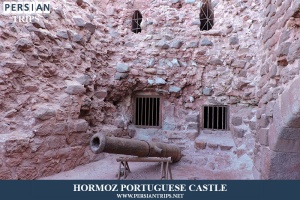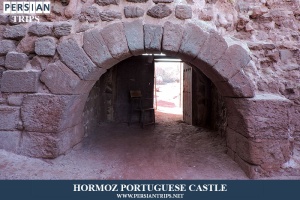Hormoz Portuguese Castle

Portuguese Castles are located in almost all areas of the Persian Gulf, including Qeshm, Kong, Oman, Ras al-Kheimah, and Qeshm Ports in addition to Hormuz Island in Hormozgan Province.
The Portuguese Castle on Hormuz Island, located on the northern side of the island on the coast, is the most important fortress left from the time of Portuguese domination over the coasts and islands of the Persian Gulf. The castle was built by the decree of Alfonso Alberkerk, a Portuguese sailor, in a place called Morena in 1507. According to documents and evidence, no trace of Alberkerk statue, which was made of stone and placed in the middle of the courtyard on a pedestal of the same material, remains today. Later, when Shah Abbas Safavid ousted the Portuguese from the Persian Gulf, the Portuguese Castle on Hormoz island was the first place to be recaptured by Iranian generals under the command of Imam Qoli Khan. During the occupation of Iran, the Portuguese built these buildings to house the military forces often in a short distance from the main ports. This castle, which was built less than one kilometer from the main pier of the island, is considered as the only historical monument on the island.
Architectural Features of the Portuguese Castle
According to the available evidence, Portuguese Castle had two floors. On the southern front of the building, there are some spaces that are different from other parts; in this section, the command quarter, halls, prison and other important spaces were probably located. This fortified castle has walls with a diameter of 3.5 meters and several 12-meter towers; all these measures were done to create more impenetrability. Entrances are located on all four corners of the building, in a way that any entry and exit can be controlled from the watch towers located above the entrances. Most of the entrances, which had only one door, were on the south side and made way to the city from the land; the entrances are 1.5 meters wide with a wooden and stone door. The resting place for the guards of the watchtower, ammunition depot and the deployment of cannons on the roof of these entrances were predicted. While carved stones were used for decorations and facades, green coral stones were used to erect the walls, which were extracted from the surrounding mines on the island.
Portuguese Castle Reservoir
The central courtyard of the Portuguese Castle contains spaces, coated with sarooj water-resistant material, that may have been the place to collect rainwater and then transfer the collected water to the reservoir. The reservoir of this castle is located on the second floor, which is an interesting example of architecture in the southern coasts and islands; the general form of this reservoir is oval. The roof of the reservoir is erected by arches between the columns, which are made of gypsum; the roof is flat from the outside with a vent in it. The construction time of this reservoir probably dates back to early Safavid era. In addition to storing and keeping the water cool, the construction of this reservoir also paid enough attention to resistance against artillery attacks. One of the other spaces in the courtyard of the Portuguese Castle is the church; this rectangular part goes down to the underground with five steps. The church has two rows of circular columns and each row has 5 columns with beautiful arches carved from coral stones.
Tags: Hormozgan Province, Hormozgan Attractions, Iran Historical Attractions, Castles in Iran, Hormoz Portuguese Castle

